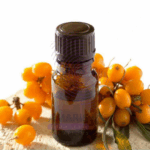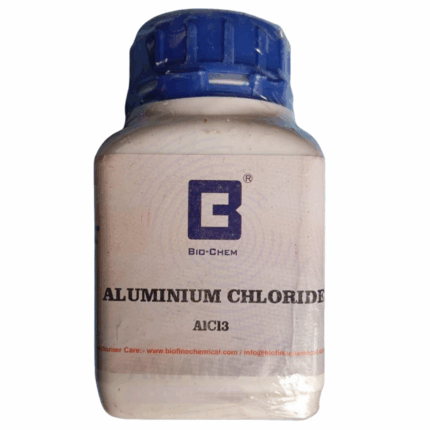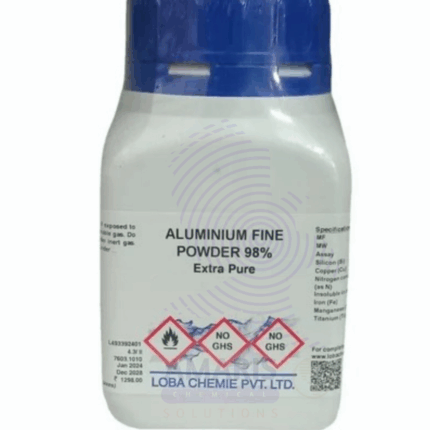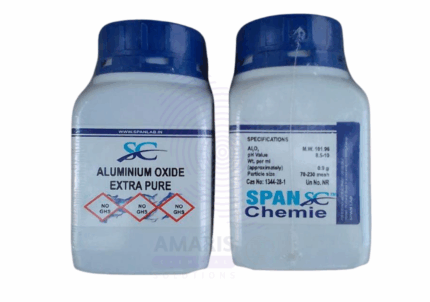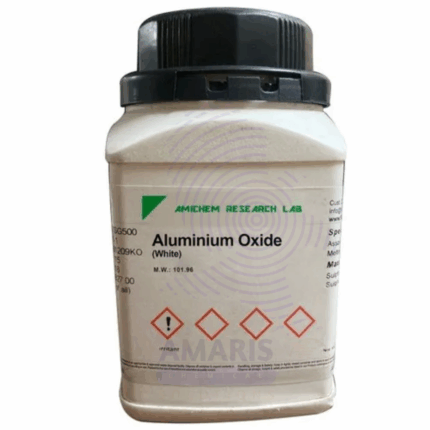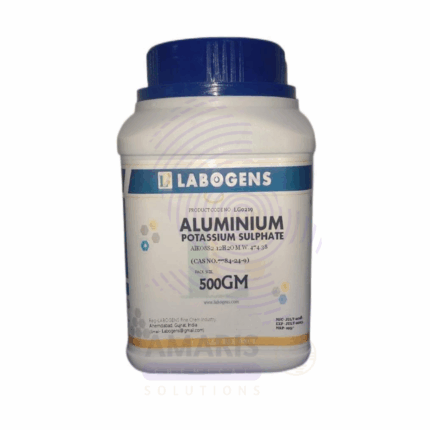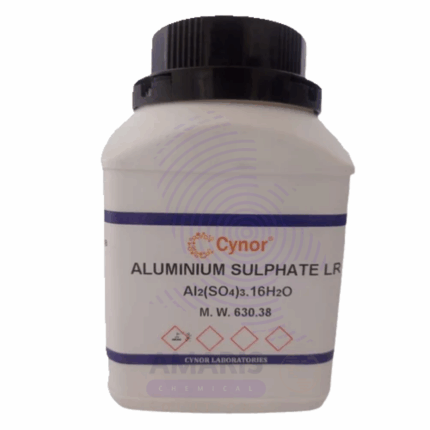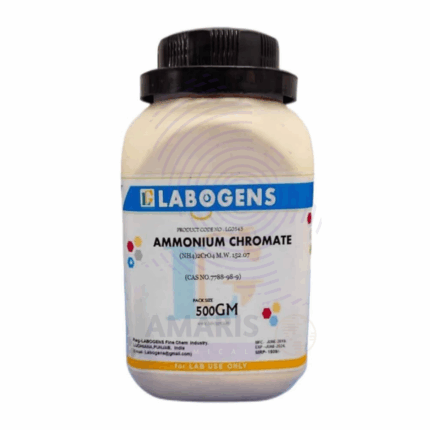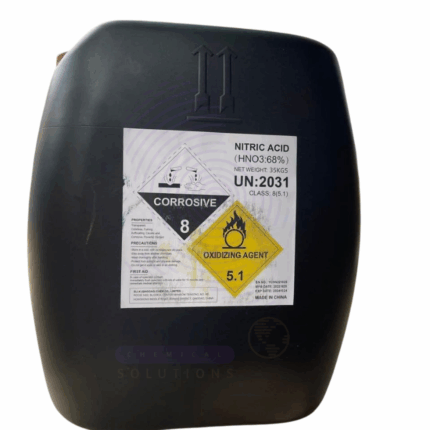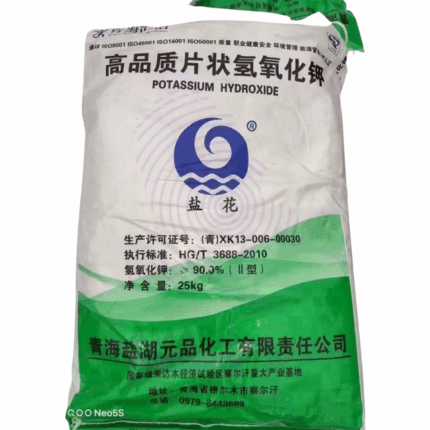Benzene Extra Pure
$ 39.00 Original price was: $ 39.00.$ 38.24Current price is: $ 38.24.
Benzene Extra Pure is a high-purity, clear, highly volatile, and flammable liquid with a characteristic aromatic odor, used extensively in laboratory settings for analytical, organic, and physical chemistry applications. It serves as a non-polar solvent for a wide range of chemical reactions, particularly in the study of aromatic compounds, electrophilic substitution mechanisms, and polymer chemistry. Its stability and solvency make it suitable for sample preparation, purification processes, and spectral analysis. The extra pure grade ensures minimal impurities, delivering consistent results in precision research. Due to its toxic and carcinogenic nature, benzene must be handled in a well-ventilated fume hood with appropriate protective equipment and stored in tightly sealed containers away from heat, sparks, and oxidizers.
Benzene Extra Pure
Primary Uses
- Solvent in Organic Chemistry
- Benzene is a non-polar solvent used in dissolving non-polar compounds, especially in organic synthesis, chromatography, and recrystallization of certain organic materials.
- Starting Material for Aromatic Compounds
- Acts as a precursor or reagent in synthetic pathways for preparing derivatives like nitrobenzene, phenol, aniline, and styrene in experimental organic chemistry.
- Study of Aromaticity and Electrophilic Substitution
- Used in lab demonstrations of electrophilic aromatic substitution (EAS) reactions such as nitration, halogenation, sulfonation, and Friedel–Crafts alkylation/acylation.
- Spectroscopic Calibration Standard
- Pure benzene is used in UV-Vis and IR spectroscopy as a reference material due to its characteristic absorption bands and high purity.
Secondary Uses
- Demonstration of Physical Properties
- A classic subject in boiling point determination, vapor pressure studies, and miscibility experiments due to its well-defined thermodynamic properties.
- Chromatographic Study Solvent
- Occasionally used in liquid–liquid extraction or column chromatography for separation of non-polar substances, though often replaced with safer alternatives.
- Model Compound in Thermodynamic and Quantum Chemistry
- Ideal for molecular modeling studies (π-conjugation, aromaticity, molecular orbital theory), and often cited in NMR and quantum simulations.
- Reactant in Controlled Laboratory Nitration
- Used to demonstrate formation of nitrobenzene under controlled, small-scale nitration reactions in advanced lab courses.
| PACK SIZE |
2.5 Litres Glass bottle |
|---|
1. Basic Identification Attributes
- Chemical Name: Benzene
- CAS Number: 71-43-2
- HS Code: 2902.20.00
- Molecular Formula: C₆H₆
- Synonyms:
- Cyclohexatriene
- Benzol
- Phenyl hydride
2. Physical & Chemical Properties
- Physical State: Liquid
- Color & Odor: Colorless, with a sweet, aromatic odor
- Boiling Point: 80.1 °C
- Melting Point: 5.5 °C
- Density: 0.8765 g/cm³ at 20 °C
- Solubility:
- In Water: Slightly soluble (~1.8 g/L at 25 °C)
- In Organic Solvents: Miscible with alcohol, ether, acetone, chloroform
- pH Level: Not applicable (neutral organic compound)
- Vapor Pressure: 12.7 kPa at 25 °C
- Flash Point: -11.1 °C (closed cup)
- Autoignition Temperature: 498 °C
- Viscosity: 0.604 mPa·s at 25 °C
3. Safety & Hazard Attributes (Laboratory Context)
- GHS Classification:
- Flammable Liquid (Category 2)
- Carcinogenicity (Category 1A)
- Specific Target Organ Toxicity – Repeated Exposure (Category 1)
- NFPA Ratings:
- Health: 2
- Flammability: 3
- Reactivity: 0
- Exposure Limits:
- OSHA PEL: 1 ppm (TWA); 5 ppm (STEL)
- ACGIH TLV: 0.5 ppm (TWA); 2.5 ppm (STEL)
- Reactivity:
- Stable under normal conditions
- Reacts with strong oxidizers and halogens
4. Storage & Handling Attributes
- Storage Conditions:
- Store in tightly closed containers in a cool, well-ventilated area
- Keep away from heat, sparks, open flames
- Incompatible Materials:
- Strong oxidizing agents (e.g., nitric acid, chromates)
- Container Type:
- Amber glass or stainless steel under inert atmosphere (if long term)
- Shelf Life:
- Stable if stored properly — usually up to 2 years
- Special Handling Requirements:
- Use in fume hood
- Wear gloves, goggles, lab coat
- Avoid inhalation and skin contact
5. Regulatory & Compliance Attributes
- Regulatory Status:
- Listed under REACH, TSCA, IARC, OSHA, EPA
- Hazard Symbols (GHS):
- UN Number: UN1114
- Hazard Class (DOT): 3 (Flammable liquid)
- Waste Disposal Method:
- Dispose of in accordance with local hazardous waste regulations
- Avoid release into drains and environment
6. Environmental & Health Impact
- Ecotoxicity:
- Toxic to aquatic organisms
- May cause long-term adverse effects in the aquatic environment
- Persistence:
- Volatile and moderately persistent in air
- Carcinogenicity/Mutagenicity:
- Classified as Group 1 carcinogen by IARC
- Known to cause leukemia with chronic exposure
- Biodegradability:
- Readily biodegradable under aerobic conditions
SAFETY PRECAUTIONS
- Personal Protective Equipment (PPE):
- Wear chemical-resistant gloves (e.g., nitrile), safety goggles, and a lab coat.
- Use a fume hood—never handle benzene in open air in a lab.
- Handling:
- Avoid inhalation and skin contact—benzene is highly toxic and carcinogenic.
- Keep containers tightly sealed.
- Ground all equipment when transferring to prevent static ignition.
- Storage:
- Store in a flammable liquids cabinet away from heat, sparks, oxidizers, and incompatible reagents (e.g., nitric acid, peroxides).
- Use amber bottles to protect from light degradation.
- Hygiene Measures:
- Wash hands and arms thoroughly after use.
- Remove contaminated clothing immediately.
FIRST AID MEASURES
- Inhalation:
- Move the person to fresh air immediately.
- Provide oxygen if breathing is difficult.
- Seek emergency medical attention.
- Skin Contact:
- Rinse thoroughly with soap and water.
- Remove contaminated clothing.
- Eye Contact:
- Rinse cautiously with water for at least 15 minutes.
- Seek medical attention if irritation persists.
- Ingestion:
- Do not induce vomiting—aspiration risk.
- Rinse mouth.
- Call poison control or emergency medical services immediately.
FIRE FIGHTING MEASURES
- Extinguishing Media:
- Use dry chemical, foam, or carbon dioxide (CO₂).
- Avoid water jets—may spread the fire.
- Fire Hazards:
- Extremely flammable—vapors can travel and ignite far from the source.
- Explosive vapor/air mixtures are possible.
- Combustion releases toxic gases like carbon monoxide and dioxide.
- Protective Equipment:
- Use self-contained breathing apparatus (SCBA) and full fire-resistant gear.
- Firefighting Instructions:
- Cool exposed containers with water spray.
- Prevent spillage from entering drains or waterways.


 Preservatives(food)
Preservatives(food) Flavor Enhancers
Flavor Enhancers Acidulants
Acidulants Sweeteners
Sweeteners Antioxidants
Antioxidants Colorants(food)
Colorants(food) Nutraceutical Ingredients (food)
Nutraceutical Ingredients (food) Nutrient Supplements
Nutrient Supplements Emulsifiers
Emulsifiers
 Collectors
Collectors Dust Suppressants
Dust Suppressants Explosives and Blasting Agents
Explosives and Blasting Agents Flocculants and Coagulants
Flocculants and Coagulants Frothers
Frothers Leaching Agents
Leaching Agents pH Modifiers
pH Modifiers Precious Metal Extraction Agents
Precious Metal Extraction Agents
 Antioxidants(plastic)
Antioxidants(plastic) Colorants (Pigments, Dyes)
Colorants (Pigments, Dyes) Fillers and Reinforcements
Fillers and Reinforcements Flame Retardants
Flame Retardants Monomers
Monomers Plasticizers
Plasticizers Polymerization Initiators
Polymerization Initiators Stabilizers (UV, Heat)
Stabilizers (UV, Heat)
 Antifoaming Agents
Antifoaming Agents Chelating Agents
Chelating Agents Coagulants and Flocculants
Coagulants and Flocculants Corrosion Inhibitors
Corrosion Inhibitors Disinfectants and Biocides
Disinfectants and Biocides Oxidizing Agents
Oxidizing Agents pH Adjusters
pH Adjusters Scale Inhibitors( water)
Scale Inhibitors( water)
 Antioxidants(cosmetic)
Antioxidants(cosmetic) Emollients
Emollients Fragrances and Essential Oils
Fragrances and Essential Oils Humectants
Humectants Preservatives
Preservatives Surfactants(cosmetic)
Surfactants(cosmetic) Thickeners
Thickeners UV Filters
UV Filters
 Fertilizers
Fertilizers Soil Conditioners
Soil Conditioners Plant Growth Regulators
Plant Growth Regulators Animal Feed Additives
Animal Feed Additives Biostimulants
Biostimulants Pesticides (Herbicides, Insecticides, Fungicides)
Pesticides (Herbicides, Insecticides, Fungicides)
 Active Pharmaceutical Ingredients (APIs)
Active Pharmaceutical Ingredients (APIs) Excipients
Excipients Solvents(pharmaceutical)
Solvents(pharmaceutical) Antibiotics
Antibiotics Antiseptics and Disinfectants
Antiseptics and Disinfectants Vaccine Adjuvants
Vaccine Adjuvants Nutraceutical Ingredients (pharmaceutical)
Nutraceutical Ingredients (pharmaceutical) Analgesics & Antipyretics
Analgesics & Antipyretics
 Analytical Reagents
Analytical Reagents Solvents(lab)
Solvents(lab) Chromatography Chemicals
Chromatography Chemicals Spectroscopy Reagents
Spectroscopy Reagents microbiology-and-cell-culture-reagents
microbiology-and-cell-culture-reagents Molecular Biology Reagents
Molecular Biology Reagents Biochemical Reagents
Biochemical Reagents Inorganic and Organic Standards
Inorganic and Organic Standards Laboratory Safety Chemicals
Laboratory Safety Chemicals Specialty Laboratory Chemicals(Special Laboratory Equipment)
Specialty Laboratory Chemicals(Special Laboratory Equipment)
 Demulsifiers
Demulsifiers Hydraulic Fracturing Fluids
Hydraulic Fracturing Fluids Scale Inhibitors(oil)
Scale Inhibitors(oil) Surfactants(oil)
Surfactants(oil) Drilling Fluids
Drilling Fluids
 Dyes and Pigments
Dyes and Pigments Bleaching Agents
Bleaching Agents Softening Agents
Softening Agents Finishing Agents
Finishing Agents Antistatic Agents
Antistatic Agents
 Admixtures
Admixtures Waterproofing Agents
Waterproofing Agents Sealants and Adhesives
Sealants and Adhesives Curing Compounds
Curing Compounds Concrete Repair Chemicals
Concrete Repair Chemicals Anti-Corrosion Coatings
Anti-Corrosion Coatings
 Surfactants(cleaning)
Surfactants(cleaning) Builders
Builders Enzymes
Enzymes Solvents (Cleaning)
Solvents (Cleaning) Fragrances
Fragrances
 Electronic Chemicals
Electronic Chemicals Catalysts
Catalysts Lubricants
Lubricants Photographic Chemicals
Photographic Chemicals Refrigerants
Refrigerants Automotive chemicals
Automotive chemicals Pyrotechnic Chemicals
Pyrotechnic Chemicals
 Biodegradable Surfactants
Biodegradable Surfactants Bio-based Solvents
Bio-based Solvents Renewable Polymers
Renewable Polymers Carbon Capture Chemicals
Carbon Capture Chemicals Wastewater Treatment Chemicals
Wastewater Treatment Chemicals
 Pigments
Pigments Solvents(paint)
Solvents(paint) Specialty Coatings
Specialty Coatings Binders/Resins
Binders/Resins Additives
Additives Driers
Driers Anti-Corrosion Agents
Anti-Corrosion Agents Functional Coatings
Functional Coatings Application-Specific Coatings
Application-Specific Coatings
 Fresh Herbs
Fresh Herbs Ground Spices
Ground Spices Whole Spices
Whole Spices Spice Blends
Spice Blends Dried Herbs
Dried Herbs
 Leavening Agents
Leavening Agents Dough Conditioners
Dough Conditioners Flour Treatments
Flour Treatments Fat Replacers
Fat Replacers Decoratives
Decoratives Preservatives(baking)
Preservatives(baking)
 Plasticizers & Softeners
Plasticizers & Softeners Reinforcing Agents
Reinforcing Agents Adhesion Promoters
Adhesion Promoters Vulcanizing Agents
Vulcanizing Agents Antidegradants
Antidegradants Blowing Agents
Blowing Agents Fillers & Extenders
Fillers & Extenders Accelerators & Retarders
Accelerators & Retarders
